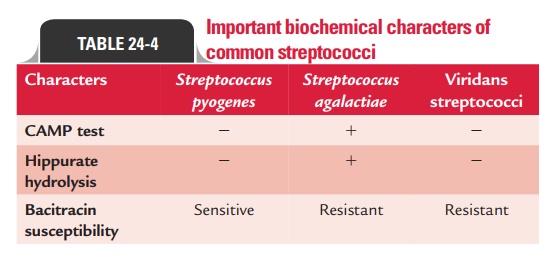Chapter: Microbiology and Immunology: Bacteriology: Streptococcus and Enterococcus
Viridans Streptococci
Viridans Streptococci
Viridans streptococci are a heterogenous group of alpha-hemolytic and nonhemolytic streptococci. These are found as commensal flora in the oral cavity, oropharynx, gastro-intestinal tract, and genitourinary tract. These bacteria pro-duce a green pigment on the blood agar and hence are called viridans (Latin for “green”). Most isolates of viridans strep-tococci do not possess a group-specific carbohydrate; hence, they cannot be classified under Lancefield classification of streptococci.
These cocci, however, have been classified into differ-ent species, such as Streptococcus mutans, Streptococcus sanguis,
Streptococcus mitis, S. salivarius, etc. based on various properties,such as (a) cell wall composition, (b) production of dextrans and levans, and (c) fermentation of sugars.
Viridans streptococci are nutritionally fastidious, requiring complex media supported with blood for their growth. Growth of the colonies is facilitated by the presence of 5–10% carbon dioxide. Some strains are nutritionally deficient, requiring supplementation of pyridoxal, the active form of vitamin B6 for their growth.
Viridans streptococci can cause a variety of infections. They are commonly implicated in dental caries, subacute bacterial endocarditis, and intra-abdominal suppurative infections.
S. sanguis is the most common causative agent of bacterialendocarditis in individuals with preexisting heart lesions. There is a transient bacteremia following tooth extraction or other dental procedures after which bacteria adhere to the damaged heart valves or prosthetic heart valves. Prophylac-tic use of antibiotics before dental procedures prevents such complications.
S. mutans is an important causative agent of dental caries.It splits dietary sucrose, producing acid and a dextran. The acid damages the dentine. The dextran binds together exfo-liative epithelial cells, mucus, food debris, and bacteria to form dental plaques.
Earlier, most strains of viridans streptococci were sensitive to penicillins. However, recently moderately resistant and highly resistant strains have been reported particularly in the S. mitis group. Broad-spectrum cephalosporins or vancomycin are rec-ommended for treatment of these penicillin-resistant strains.
Table 24-4 summarizes the differences between important biochemical characteristics of common streptococci.

Related Topics